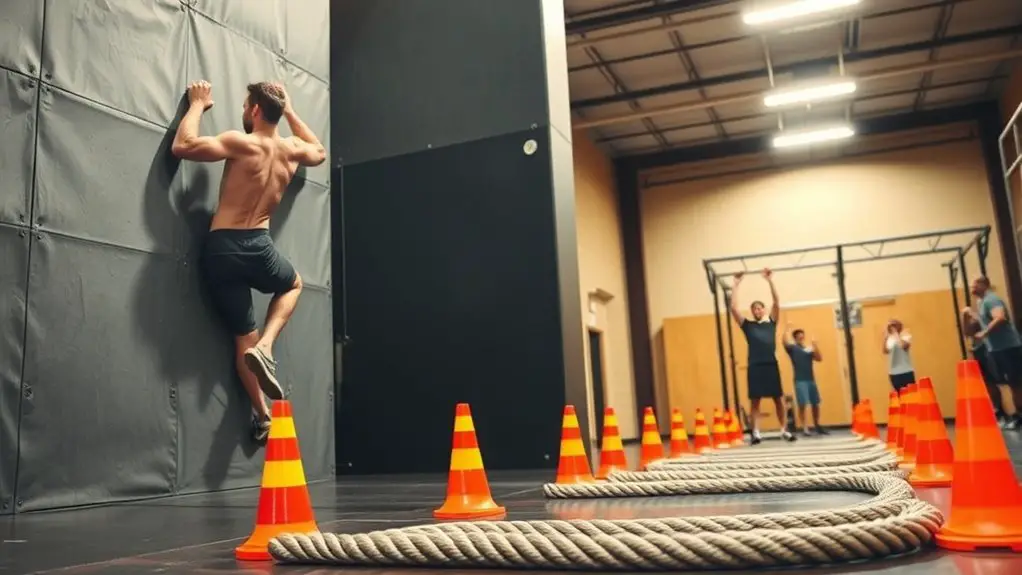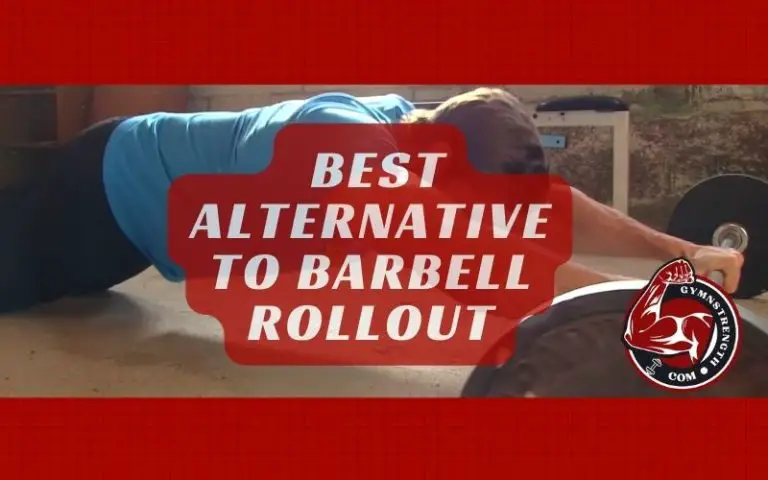How to Train for an Obstacle Course Race at the Gym

To train for an obstacle course race at the gym, focus on building strength, endurance, agility, and grip strength. Incorporate bodyweight exercises, cardio workouts like running and cycling, and agility drills to enhance performance. Don’t forget to practice skills specific to obstacles, such as climbing and crawling. Set clear goals and track your progress to stay motivated. With the right approach, you’ll be well-prepared to tackle any challenge that comes your way. There’s more to explore on this journey!
Understanding the Basics of Obstacle Course Racing

Obstacle course racing (OCR) combines physical endurance with mental resilience, making it an exciting challenge for anyone willing to push their limits. To excel in OCR, it’s essential to understand key obstacle techniques and effective race strategies. Start by familiarizing yourself with common obstacles like walls, mud pits, and rope climbs. Practicing these techniques safely is vital; always prioritize your safety and the safety of others around you.
Incorporate race strategies by planning your approach to each obstacle. Consider pacing yourself to conserve energy, and visualize how you’ll tackle each challenge. Break down obstacles into manageable steps, allowing for quick recovery if you stumble. Remember, the goal’s not just to finish but to enjoy the journey while staying injury-free. Finally, connect with others in the OCR community to share tips and experiences, enhancing your understanding and preparation for race day.
Building Strength for OCR Challenges
To conquer the diverse challenges of an obstacle course race, you’ll need to build a solid foundation of strength. Start with strength training, focusing on key muscle groups that you’ll rely on during the race. Incorporate bodyweight exercises like push-ups, pull-ups, squats, and lunges to enhance functional strength without the risk of injury from heavy weights.
Aim for a balanced routine that targets your upper body, core, and legs, ensuring you develop the necessary stability and power. Don’t forget to include exercises that mimic race obstacles, such as climbing or crawling movements, to prepare your muscles for the specific demands of the course. Additionally, consider incorporating AB Wheel alternatives to further enhance your core strength and stability.
Listen to your body and allow for rest days to promote recovery and prevent overtraining. By prioritizing safety and proper technique, you’ll build the strength needed to tackle any obstacle that comes your way.
Enhancing Endurance Through Cardio Workouts

While strength is essential for tackling obstacles, endurance plays an equally important role in your performance during an obstacle course race. To enhance your endurance safely, consider incorporating these cardio workouts into your routine:
- Interval Training: Alternate between high-intensity bursts and lower-intensity recovery periods. This method boosts your cardiovascular fitness and mimics the race’s demands.
- Long, Steady Runs: Gradually increase your distance to build a strong aerobic base, essential for endurance.
- Hill Sprints: Find a hill and sprint up it, then walk or jog down. This builds strength and endurance simultaneously.
- Cross-Training: Engage in activities like cycling or swimming to reduce the risk of injury while improving your endurance.
Developing Agility With Functional Training
Agility is essential for maneuvering through the varied challenges of an obstacle course race, and functional training is one of the best ways to develop it. Start by incorporating agility ladders into your routine to enhance foot speed and coordination. Pair this with balance exercises that stabilize your core and improve your overall control. Plyometric drills, like jump squats, will boost your explosive power, vital for overcoming obstacles. Don’t forget about speed hurdles and agility cones; they’re excellent for practicing lateral movements and quick direction changes. Incorporating dynamic stretches will prepare your muscles for these movements and reduce injury risk. Focus on coordination training to enhance your body’s awareness in various positions, making obstacle maneuvering smoother. By integrating these functional movements into your workouts, you’ll build the agility needed to conquer any obstacle course with confidence and safety.
Incorporating Grip Strength Exercises

When training for an obstacle course race, grip strength can’t be overlooked. You’ll want to explore essential tools and effective workouts that specifically target this area. By incorporating these elements, you’ll enhance your overall performance and confidence on the course.
Essential Grip Strength Tools
To conquer an obstacle course race, having a strong grip is essential, as it allows you to navigate various challenges with confidence. Using the right tools can enhance your grip strength effectively and safely. Here are some important grip strength tools you should consider incorporating into your training:
- Fat Gripz: These add thickness to your bars, improving grip during exercises like climbing hangs.
- Farmers Handles: Perfect for farmer carries, they help develop grip endurance and overall stability.
- Resistance Bands: Great for dynamic grip exercises, making your training more versatile.
- Hanging Rings: Excellent for practicing climbing hangs, they engage your grip while improving coordination.
Utilizing these tools will guarantee you’re well-prepared for your race while prioritizing safety.
Effective Grip Workouts
Effective grip workouts are essential for building the strength and endurance you’ll need to tackle an obstacle course race. Incorporating dynamic grip techniques into your routine can greatly improve your performance. Start with exercises like hanging from a pull-up bar, which not only enhances grip strength but also engages your core. You can also include grip endurance workouts, such as farmer’s walks, where you carry heavy weights over a distance. Remember to prioritize safety by using proper form and starting with manageable weights to avoid injury. Gradually increase the intensity as your grip strength improves. Finally, don’t forget to rest your hands to allow for recovery, ensuring you stay strong and ready for race day.
Practicing Obstacle-Specific Skills
To conquer an obstacle course race, you need to practice skills that are specific to the challenges you’ll face. This means incorporating grip strength exercises and agility drills into your training routine. By honing these abilities, you’ll boost your confidence and performance on race day.
Grip Strength Exercises
Grip strength is essential for conquering obstacles in races, and incorporating specific exercises into your training routine can make a significant difference. To enhance your grip strength safely, try these exercises focusing on advanced grip variations:
- Dead Hangs: Hang from a pull-up bar, engaging your shoulders and core for support.
- Farmers Walk: Carry heavy dumbbells or kettlebells in each hand, maintaining good posture while walking.
- Towel Pull-Ups: Wrap a towel around the bar and perform pull-ups, which increases grip demand.
- Plate Pinches: Hold two weight plates together using just your fingers for timed intervals.
Incorporating these exercises will help you improve grip strength, ensuring you’re prepared for any obstacle course challenge.
Agility and Balance Drills
Building on your grip strength, agility and balance are key components in mastering obstacle-specific skills. To improve these areas, incorporate ladder drills and balance beams into your training routine. These exercises not only enhance coordination but also boost your confidence on the course.
Here’s a quick guide to get you started:
| Exercise | Description | Safety Tips |
|---|---|---|
| Ladder Drills | Quick foot movements through rungs | Guarantee stable footing |
| Balance Beams | Walking across narrow beams | Use a spotter if needed |
| Lateral Hops | Side-to-side jumps | Land softly to avoid injury |
Creating a Balanced Training Schedule
While preparing for an obstacle course race, it is vital to create a balanced training schedule that incorporates various elements of fitness. This approach helps you maximize cross training benefits while minimizing injury risk.
Here’s a suggested weekly plan:
- Strength Training: Focus on core and upper body exercises, targeting muscles used in obstacles.
- Cardio Workouts: Incorporate running, cycling, or rowing to build endurance.
- Agility and Balance Drills: Include exercises that improve coordination and stability, essential for maneuvering obstacles.
- Rest and Recovery: Prioritize rest days and engage in recovery strategies like stretching, foam rolling, or yoga to aid muscle repair.
Setting Goals and Tracking Progress
Setting clear goals and tracking your progress can greatly enhance your training for an obstacle course race. To stay motivated and safe, break down your goals into manageable steps. This way, you can gradually build your strength and endurance without risking injury.
Here’s a simple table to help you with goal setting and progress tracking:
| Goal | Target Date | Progress Tracking |
|---|---|---|
| Increase running distance | 4 weeks | Weekly distance log |
| Complete 10 burpees | 2 weeks | Daily completion chart |
| Master monkey bars | 6 weeks | Bi-weekly practice log |
| Improve grip strength | 5 weeks | Weekly weight log |
| Finish a practice race | 8 weeks | Race day notes |
Frequently Asked Questions
What Should I Wear for an Obstacle Course Race?
When you’re choosing what to wear for an obstacle course race, prioritize comfort and safety. For footwear options, opt for trail running shoes with good grip and support to handle various terrains. As for clothing materials, breathable, moisture-wicking fabrics are best; they’ll keep you dry and comfortable throughout the race. Avoid cotton, as it retains water and can lead to chafing. Remember, you want to focus on the course, not your outfit!
How Do I Choose the Right Race for My Skill Level?
Choosing the right race for your skill level’s like picking the perfect shoe that just fits. Start with a skill assessment—think about your endurance, strength, and comfort with obstacles. If you’re a beginner, look for races labeled “easy” or “novice,” focusing on lower race difficulty. You want to challenge yourself but stay safe, so don’t bite off more than you can chew. Remember, it’s all about enjoying the journey while pushing your limits!
What Nutrition Strategies Should I Follow Before the Race?
Before your race, focus on nutrition to fuel your performance. Opt for pre-race meals rich in carbohydrates, like oatmeal or whole grain toast, to boost energy levels. It’s vital to hydrate properly, too; drink water throughout the week leading up to the race, and consider electrolyte drinks on race day for peak hydration. Avoid heavy foods right before the start, and listen to your body to guarantee you’re feeling your best.
Can I Train for an Obstacle Course Race at Home?
Yes, you can definitely train for an obstacle course race at home! Home workouts can be just as effective, especially with the right equipment options. You might use resistance bands, dumbbells, or even your body weight for strength training. Incorporate exercises like burpees, squats, and planks to build endurance and agility. Just make sure you’re using proper form to stay safe while pushing your limits. Consistency is key, so create a plan and stick to it!
What Should I Do if I Get Injured During Training?
Imagine you’re in the middle of a tough training session, and suddenly, pain strikes. What should you do? First, don’t panic. Focus on injury prevention, and immediately assess the situation. Rest is vital, so stop your workout. Ice the injury and elevate it to reduce swelling. Consider using recovery techniques like gentle stretching and foam rolling once the pain eases. If it doesn’t improve, consult a healthcare professional to guarantee you stay safe and healthy.





